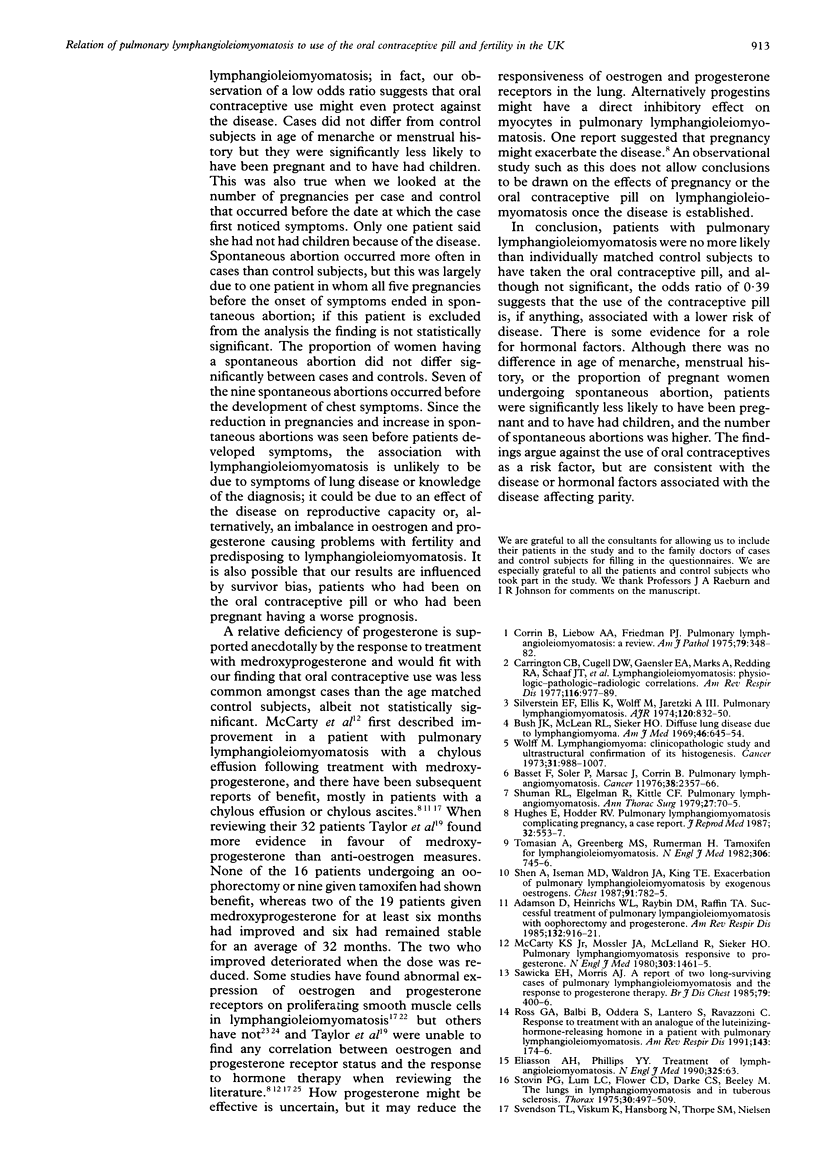Abstract
BACKGROUND--Pulmonary lymphangioleiomyomatosis is a rare progressive disease of unknown aetiology affecting premenopausal women. Since the oral contraceptive pill has been implicated in its pathogenesis, a case control study was carried out to determine whether women with the disease were more likely to have taken the oral contraceptive pill, and whether the disease was associated with other conditions related to sex hormones including pregnancy, parity, and fibroids. METHODS--All chest physicians in the UK were asked for details of all live patients with pulmonary lymphangioleiomyomatosis; the patient's family doctor was then asked for four age and sex matched control subjects from their patient register. Details of lifetime use of the oral contraceptive pill, pregnancy, parity, history of fibroids, and smoking were obtained from cases and controls. Relative odds of exposure to potential risk factors were estimated by conditional logistic regression. RESULTS--Medical details were obtained from all 23 cases of lymphangioleiomyomatosis identified; questionnaires were completed by 21 cases (one by proxy) and by 46 matched controls of mean (SD) age 43 (10) and 44 (11) years, respectively. The patients had a mean age of 34 (9) years at onset of symptoms and a median (range) time of 2 (0-29) years from onset of symptoms to diagnosis. Compared with control subjects, cases did not differ in the use of the oral contraceptive pill (odds ratio (OR) 0.39, 95% CI 0.09 to 1.68), diagnosis of fibroids (OR 3.12; 95% CI 0.52 to 18.7), age of menarche, menstrual history, or lifetime smoking. They were, however, less likely to have been pregnant (OR 0.14, 95% CI 0.03 to 0.71) or to have had children (OR 0.13, 95% CI 0.03 to 0.67). More pregnancies had ended in spontaneous abortion (28% v 8%) but the proportion of women undergoing spontaneous abortion was similar in cases and controls (OR 2.13, 95% CI 0.47 to 9.3). CONCLUSIONS--This study does not support the hypothesis that use of the oral contraceptive pill is causally associated with the development of pulmonary lymphangioleiomyomatosis. Sex hormones may be involved, however, since patients were less likely to have been pregnant or to have had children, and tended to have had more spontaneous abortions and an increased incidence of fibroids.
Full text
PDF




Selected References
These references are in PubMed. This may not be the complete list of references from this article.
- Adamson D., Heinrichs W. L., Raybin D. M., Raffin T. A. Successful treatment of pulmonary lymphangiomyomatosis with oophorectomy and progesterone. Am Rev Respir Dis. 1985 Oct;132(4):916–921. doi: 10.1164/arrd.1985.132.4.916. [DOI] [PubMed] [Google Scholar]
- Baldi S., Papotti M., Valente M. L., Rapellino M., Scappaticci E., Corrin B. Pulmonary lymphangioleiomyomatosis in postmenopausal women: report of two cases and review of the literature. Eur Respir J. 1994 May;7(5):1013–1016. [PubMed] [Google Scholar]
- Banner A. S., Carrington C. B., Emory W. B., Kittle F., Leonard G., Ringus J., Taylor P., Addington W. W. Efficacy of oophorectomy in lymphangioleiomyomatosis and benign metastasizing leiomyoma. N Engl J Med. 1981 Jul 23;305(4):204–209. doi: 10.1056/NEJM198107233050406. [DOI] [PubMed] [Google Scholar]
- Brentani M. M., Carvalho C. R., Saldiva P. H., Pacheco M. M., Oshima C. T. Steroid receptors in pulmonary lymphangiomyomatosis. Chest. 1984 Jan;85(1):96–99. doi: 10.1378/chest.85.1.96. [DOI] [PubMed] [Google Scholar]
- Bush J. K., McLean R. L., Sieker H. O. Diffuse lung disease due to lymphangiomyoma. Am J Med. 1969 Apr;46(4):645–654. doi: 10.1016/0002-9343(69)90084-9. [DOI] [PubMed] [Google Scholar]
- Carrington C. B., Cugell D. W., Gaensler E. A., Marks A., Redding R. A., Schaaf J. T., Tomasian A. Lymphangioleiomyomatosis. Physiologic-pathologic-radiologic correlations. Am Rev Respir Dis. 1977 Dec;116(6):977–995. doi: 10.1164/arrd.1977.116.6.977. [DOI] [PubMed] [Google Scholar]
- Colley M. H., Geppert E., Franklin W. A. Immunohistochemical detection of steroid receptors in a case of pulmonary lymphangioleiomyomatosis. Am J Surg Pathol. 1989 Sep;13(9):803–807. doi: 10.1097/00000478-198909000-00011. [DOI] [PubMed] [Google Scholar]
- Corrin B., Liebow A. A., Friedman P. J. Pulmonary lymphangiomyomatosis. A review. Am J Pathol. 1975 May;79(2):348–382. [PMC free article] [PubMed] [Google Scholar]
- Hauck R. W., König G., Permanetter W., Weiss M., Wöckel W., Fruhmann G. Tuberous sclerosis with pulmonary involvement. Respiration. 1990;57(4):289–292. doi: 10.1159/000195858. [DOI] [PubMed] [Google Scholar]
- Hughes E., Hodder R. V. Pulmonary lymphangiomyomatosis complicating pregnancy. A case report. J Reprod Med. 1987 Jul;32(7):553–557. [PubMed] [Google Scholar]
- McCarty K. S., Jr, Mossler J. A., McLelland R., Sieker H. O. Pulmonary lymphangiomyomatosis responsive to progesterone. N Engl J Med. 1980 Dec 18;303(25):1461–1465. doi: 10.1056/NEJM198012183032506. [DOI] [PubMed] [Google Scholar]
- McCarty K. S., Jr, Mossler J. A., McLelland R., Sieker H. O. Pulmonary lymphangiomyomatosis responsive to progesterone. N Engl J Med. 1980 Dec 18;303(25):1461–1465. doi: 10.1056/NEJM198012183032506. [DOI] [PubMed] [Google Scholar]
- Popper H. H., Gamperl R., Pongratz M. G., Kullnig P., Jüttner-Smolle F. M., Pfragner R. Chromosome typing in lymphangioleiomyomatosis of the lung with and without tuberous sclerosis. Eur Respir J. 1993 May;6(5):753–759. [PubMed] [Google Scholar]
- Rossi G. A., Balbi B., Oddera S., Lantero S., Ravazzoni C. Response to treatment with an analog of the luteinizing-hormone-releasing hormone in a patient with pulmonary lymphangioleiomyomatosis. Am Rev Respir Dis. 1991 Jan;143(1):174–176. doi: 10.1164/ajrccm/143.1.174. [DOI] [PubMed] [Google Scholar]
- Sawicka E. H., Morris A. J. A report of two long-surviving cases of pulmonary lymphangioleiomyomatosis and the response to progesterone therapy. Br J Dis Chest. 1985 Oct;79(4):400–406. doi: 10.1016/0007-0971(85)90077-4. [DOI] [PubMed] [Google Scholar]
- Shen A., Iseman M. D., Waldron J. A., King T. E. Exacerbation of pulmonary lymphangioleiomyomatosis by exogenous estrogens. Chest. 1987 May;91(5):782–785. doi: 10.1378/chest.91.5.782. [DOI] [PubMed] [Google Scholar]
- Shuman R. L., Engelman R., Kittle C. F. Pulmonary lymphangiomyomatosis. Ann Thorac Surg. 1979 Jan;27(1):70–75. doi: 10.1016/s0003-4975(10)62975-x. [DOI] [PubMed] [Google Scholar]
- Silverstein E. F., Ellis K., Wolff M., Jaretzki A., 3rd Pulmonary lymphangiomyomatosis. Am J Roentgenol Radium Ther Nucl Med. 1974 Apr;120(4):832–850. doi: 10.2214/ajr.120.4.832. [DOI] [PubMed] [Google Scholar]
- Sinclair W., Wright J. L., Churg A. Lymphangioleiomyomatosis presenting in a postmenopausal woman. Thorax. 1985 Jun;40(6):475–476. doi: 10.1136/thx.40.6.475. [DOI] [PMC free article] [PubMed] [Google Scholar]
- Stovin P. G., Lum L. C., Flower C. D., Darke C. S., Beeley M. The lungs in lymphangiomyomatosis and in tuberous sclerosis. Thorax. 1975 Oct;30(5):497–509. doi: 10.1136/thx.30.5.497. [DOI] [PMC free article] [PubMed] [Google Scholar]
- Svendsen T. L., Viskum K., Hansborg N., Thorpe S. M., Nielsen N. C. Pulmonary lymphangioleiomyomatosis: a case of progesterone receptor positive lymphangioleiomyomatosis treated with medroxyprogesterone, oophorectomy and tamoxifen. Br J Dis Chest. 1984 Jul;78(3):264–271. [PubMed] [Google Scholar]
- Taylor J. R., Ryu J., Colby T. V., Raffin T. A. Lymphangioleiomyomatosis. Clinical course in 32 patients. N Engl J Med. 1990 Nov 1;323(18):1254–1260. doi: 10.1056/NEJM199011013231807. [DOI] [PubMed] [Google Scholar]
- Tomasian A., Greenberg M. S., Rumerman H. Tamoxifen for lymphangioleiomyomatosis. N Engl J Med. 1982 Mar 25;306(12):745–746. doi: 10.1056/NEJM198203253061215. [DOI] [PubMed] [Google Scholar]
- Wolff M. Lymphangiomyoma: clinicopathologic study and ultrastructural confirmation of its histogenesis. Cancer. 1973 Apr;31(4):988–1007. doi: 10.1002/1097-0142(197304)31:4<988::aid-cncr2820310433>3.0.co;2-x. [DOI] [PubMed] [Google Scholar]


